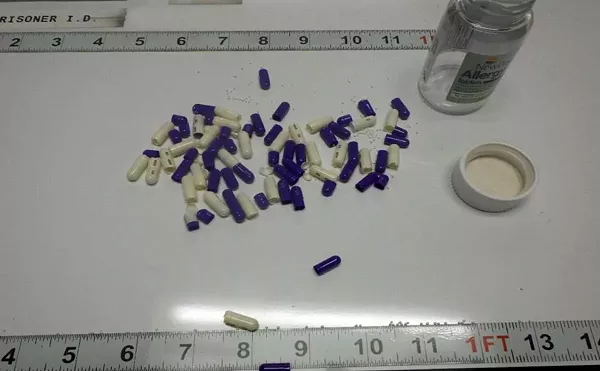It's a Wednesday afternoon in Bloomfield Hills and 20-some fidgety schoolkids snake their way through the Cranbrook Art Museum. You can tell they're getting bored. They're getting bored fast.
The unruly ones linger behind, waiting discreetly for a chance to slip away from chaperones and chase each other in circles. There's wiggling, tickling and an inner need to just stop listening. Others whisper into friends' ears, their eyes no longer trained on the works adorning the stark white walls.
Then the herd is ushered into the North Gallery and the schoolyard indifference shifts — the boredom suddenly becomes amazement. The children gasp in awe. You hear approving cries of "cool" and "wow."
See, to them, it's all about superheroes.
And no, this isn't the classic reaction you'd expect from a bunch of 9-year-olds taking in views at a world-class museum, but here it's hardly a wonder. This is Superheroes in Action, a kick-ass, world-class exhibit that sees 13 superheroes — well, their costumes — each painstakingly knitted, each hanging on a wall.
There's Batman's familiar form suspended next to Captain America. There's a Fantastic Four suit complete with an elongated body and legs dangling from the ceiling, like some heroic, ten-foot-tall piñata. Even Hawkeye from the Last of the Mohicans, which Marvel adapted, is here, sidling up to the Rawhide Kid. But there are also strange and unrecognizable costumes on display — such as Flamer, Valuesman, Y- Man and Sweaterman.
These costumes — whether classic Marvel characters or original creations — are studies in contradictions, visual representations of one man's exploration of how we are told masculinity should manifest itself.
Forty-five-year-old Mark Newport has been the head of the fiber department and artist-in-residence at Cranbrook Academy of Art since July 2007. He's a fiber artist first, but he also works with photography, videos and performance pieces.
Newport is instantly likable, soft-spoken but quietly self-assured. Today he's rearranging the museum's benches to avoid the onslaught of kids who have just, in a matter of seconds, become his biggest fans. He jokes about recording their reactions so that they can be played whenever someone enters the exhibit; he's surprised that his costumes could trigger such reaction, even from children.
It's rather odd that such an unassuming guy should focus so much of his work on spotlight-stealing cultural icons of comic-book heroes. But, then again, perhaps it's a dude like this who'd imagine himself in a costume, instantly transformed into an ass-kicking demigod, fighting for truth, justice and the American way.
But that conclusion's too easy — it's exactly that badass, masculine image that his hand-knit superheroes call into question by weaving together gender issues with the artistry of the stitch and purl, all in a pop culture context.
Newport has completed 28 costumes since he began them in 2003. In addition to the 13 displayed in Superheroes in Action, there are five on view at Lemberg Gallery as part of Alter Egos — which is a concurrent exhibit that also includes prints, photographs and embroidered comic-book covers and pages. The shows bring scrutiny to bear on the world of flying, scaling walls and leaping tall buildings in a single bound — in short, the masculine world of action — by combining it with knitting, a practice long associated with the passive feminine.
"I've always used textile work in one way or another since I was in school," Newport says, sitting on the bench that now faces the empty shells of Batman 3 and Captain America, "and since the '90s, it's usually been with the association that it's got relationships to women's work and gender. And then I fold that into these more masculine pop culture images for a contradiction."
This contrast is brought to fore with the five ironically titled Sweaterman costumes, which are split between the two exhibits, and a video work, Heroic Efforts, installed at Cranbrook. The Sweaterman series specifically explores knitting traditions — instead of heroic insignia on the chests, there are elaborately knitted cables forming braided cords or diamond-shaped patterns, reminiscent of the bulky products of grandma's laborious knitting. The colors are "typical" sweater hues — pale blue, bland beige — colors that Newport remembers his mom using to knit him and his brother sweaters in the '70s. But Sweaterman is also used to recast our preconceived notions of action-packed (read: typically male) heroism.
In a series of accompanying prints not displayed at either exhibit, Sweaterman's revealed to have the ability to knit a protective force field, an idea Newport says came from two sources — memories of his grandmother calmly knitting while the grandkids terrorized the house, and a tradition of northern European paintings that depict women doing handiwork while villainous men leer in the background. In both cases, textiles appeared to provide a safeguard, but one polar opposite the flashy "bang and pow" protection found in comic books.
In the video Heroic Efforts, Newport himself puts that super power into action by performing as Sweaterman 3 — peaceably knitting away in his rocking chair with the William Tell Overture serving as a soundtrack. As The Lone Ranger theme, the song is instantly associated with rapid movement, galloping horses — anything but the measured back-and-forth of the rocker and the quiet click-clickity-click of two needles. Newport stages such performances at galleries and art openings. At the Superheroes in Action opening, the knitter of superheroes dressed up as the Two-Gun Kid, knitting a single mitten which he handed out to an attendee, as well as passing out IOUs reading, "I owe you one protective gesture — Sweaterman."
Newport describes these performances as a way of redefining how action is perceived. Knitting is so measured and time-consuming — it takes Newport as long as five months to complete just one costume — that casting it as a heroic act seems absurd. Yet, if a mother knits her child a sweater, as Newport's mother did for him, what is that but a form of quiet protection? Newport takes this traditionally female act of nurturing and mixes it with the traditionally masculine concept of heroic action, granting neither priority.
"I'm combining two different ways of thinking about protecting people," he says.
The issue of protection resonates with Newport; he has a 15-year-old daughter and an 8-year-old son. "Being a father, there was a moment where my kids gained their own sort of independence in the neighborhood — they'd go away. I remember thinking, 'I can't keep an eye on them.' The protective impulse comes out. Then thinking, 'What is going on with that, it's just natural that they should do those things.' [The costumes] play up that idea — how do you protect someone? Who is appropriate to do that? Where do you learn that?"
In the photograph Zack Reads, on display at Lemberg, Newport's young son sits on the couch reading while Dad is framed in heroic posture outside the window. He's dressed as Bobbleman, a pink costume adorned with knitted balls known as bobbles. The use of traditional knitting technique shows Newport's actual knitting skills, but the ridiculous appearance of an overabundance of balls makes the Bobbleman costume an unlikely representation of security and strength.
The questioning of such masculine ideals continues with Batman 3, a typical Batman costume, but based on the proportions of an action figure instead of, as most of the other outfits are, an average 6-foot man. As a result, with no bulging biceps or beefcake thighs to fill it out, the arms and legs balloon comically with extra fabric, calling attention to the unrealistic role models that action figures present for boys, just as Barbie does for girls. With Y-Man, Newport was inspired by a skein of variegated thread that contained the colors he viewed as traditionally appropriate for a man to wear in the world of business: blue, beige and gray. A giant Y adorns the chest of the costume, the genetic marker for the gendered traits we are told to display.
To see them hang limply on a wall, the costumes become impotent symbols of heroism, minus the "iconic" status of Lycra and spandex. The viewer is left to wonder what kind of hero — what kind of man — would get decked out in an argyle jumpsuit. And if knitting is inherently feminine, what kind of man is holding the needles?
Newport grew up in western Massachusetts and upstate New York. His parents divorced when he was young. He was raised by his mother, whose penchant for throwing things away prevented Newport from becoming a full-on comic book fanboy. He honed his drawing skills by copying images of caped crusaders from the pages of comics. A summer spent with his grandmother was his first real introduction to knitting, a skill he promptly abandoned.
He received his Bachelor's of Fine Arts from the Kansas City Art Institute in 1986, and went on to pursue graduate studies at the School of the Art Institute of Chicago. There, Newport first began to explore issues of identity, at a time when academia was moving beyond feminism to explore more expansive definitions of gender and sexuality.
"When I was in graduate school, you were just starting to get texts — different texts — that weren't just feminism," he says. "It was gender studies or queer studies, and so there was a broader examination of how structures relate to people. But that's only possible, I think, because of feminism."
Newport first addressed gender in his work by sewing beads onto football and other trading cards, but the real-world model of the pro athlete soon gave way to the fantasy of comic book protagonists. His adventurous foray into the sartorial sphere of superheroes began in 2003, having picked knitting back up three years earlier — with help from his wife — in order to include it in a class he was teaching at Arizona State University. But embroidered comic-book covers were also in the mix — melding boyish images of youth with the prissy girlishness of sewing samplers. A stunning example on view at the Lemberg Gallery is Freedom Bedcover: Zachary, a blanket constructed of nothing but delicate comic-book pages, carefully sewn together and bordered by a plain black ribbon.
Of the gendered nature of his work, Newport says, "I think of it in practical terms as making something that reflects my own expectations of gender. I use knitting knowing that it's associated more with women than men in our culture. It's meant to sort of clash with the pop culture image of the hero and cause a kind of questioning or confusion."
If in Western culture, knitting and similar handicrafts have been relegated to the realm of women, in the world of fine arts, knitting has long been dismissed as a mere utilitarian skill — useful for accessorizing against the winter's cold, but not something that any serious artist would use in his or her work. And while knitting has enjoyed a surge of popularity in recent years as part of the DIY trend (think Stitch 'n' Bitch), it's still not a common fine arts practice.
It's this pairing of the low-culture comic-book pop with a similarly disparaged process that sets Newport apart from other contemporary fiber artists. At Cranbrook, Newport is continuing a tradition of pushing the boundaries of what fiber art is and can be. At its most basic, fiber art is any fine art using textiles that places priority both on the materials and the process which create the end product. But expanding that definition's an undertaking that, according to Gregory Wittkopp, director of Cranbrook Art Museum, Newport's is having no problem with: "He's inserting the field much more into the realm of popular culture. And that popular culture not only includes superheroes, but also includes the techniques of everyday craft making — and so knitting. Can we graft onto the field of fiber a technique never before embraced and these notions of popular culture?"
The answer is a resounding yes, as indicated recently by Newport's prestigious selection as one of four contemporary craft artists to exhibit his work in the Renwick Biennial at the Renwick Gallery in Washington, D.C.
"Real, official people chose me," Newport laughs, but as the sole fiber artist at the show, it signals that his work is gaining both attention and cachet.
"Mark's a unique voice and vision in the contemporary art world, which sometimes is difficult to find," explains Darlene Carroll, co-director of Lemberg Gallery. "He's adopting a traditional feminine means of working to explore issues of masculine identity. You don't see many men in fibers and embroidery and knitting. You don't see a lot of embroidery on comic book covers."
While superheroes may not figure prominently in fine art circles, they do loom large in America's collective consciousness. The kids gawking at Newport's costumes at Cranbrook are already molded by forces they don't understand. The star-powered Hollywood comic-book adaptations and mass-marketing barrage that plasters Spiderman's image on everything from T-shirts to lunchboxes make Newport's costumes instantly recognizable and cool to the kids, even as Newport's critique of the influence exerted by these pop culture icons goes over their heads.
"I do think in some ways that Batman, Superman — those folks — take the place in our world right now of royalty and gods and those kind of mythic people that provide the emblems of how you're supposed to act and what the culture values." And with his needles and yarn, it's those expectations that Newport carefully unravels.
Superheroes in Action is on display through March 29 at the Cranbrook Art Museum (39221 Woodward Ave., Bloomfield Hills; 248-645-3323); Alter Egos runs through March 7, at Lemberg Gallery (23241 Woodward Ave., Ferndale; 248-591-6623).
Megan O'Neil is listings editor at Metro Times. Send comments to moneil@metrotimes.com





